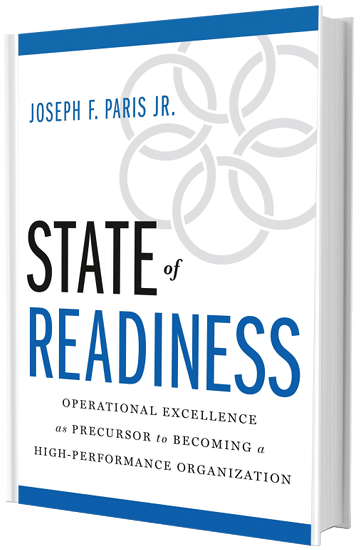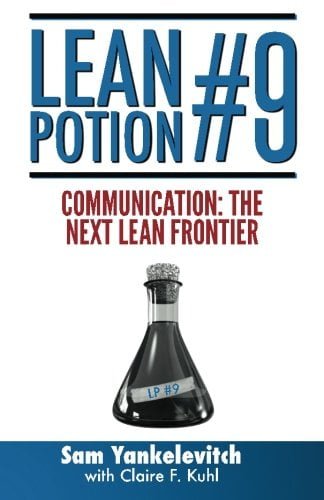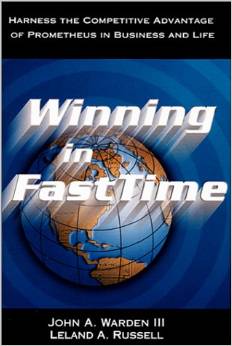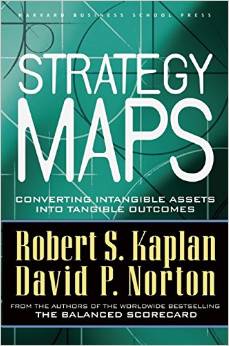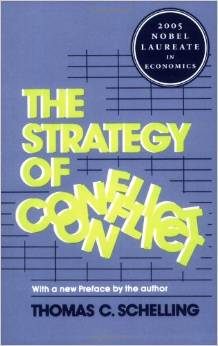State of Readiness: Operational Excellence as Precursor to Becoming a High-Performance Organization
The company of today has its supply chains and finances stretched further around the globe than ever before while simultaneously having increasing pressures to drive value across a complicated and fluid set of metrics and deliver innovations, products, and services more quickly and reliably. The competitive advantage belongs to the companies that can quicken their vision-building and strategy-execution efforts—the ones that can identify challenges more swiftly and accelerate their decision making so they are better able to formulate and deploy responses decisively yet with greater agility. To successfully accomplish this, companies will have to prioritize creating a culture of leadership that strengthens communication skills and emphasizes systems thinking by building capacity and capability that cuts across the business smokestacks and permeates the entire organization.
In State of Readiness, Joseph F. Paris Jr. shares over thirty years of international business and operations experience and guides C-suite executives and business-operations and -improvement specialists on a path toward operational excellence, the organizational capability and situational awareness that is attained as the enterprise reaches a state of alignment for pursuing its strategies. In doing so, create a corporate culture that is committed to the continuous and deliberate improvement of company performance and the circumstances of those who work there—a precursor to becoming a high-performance organization.
More info →Good to Great: Why Some Companies Make the Leap…And Others Don’t
The Challenge:
Built to Last, the defining management study of the nineties, showed how great companies triumph over time and how long-term sustained performance can be engineered into the DNA of an enterprise from the verybeginning.
But what about the company that is not born with great DNA? How can good companies, mediocre companies, even bad companies achieve enduring greatness?
The Study:
For years, this question preyed on the mind of Jim Collins. Are there companies that defy gravity and convert long-term mediocrity or worse into long-term superiority? And if so, what are the universal distinguishing characteristics that cause a company to go from good to great?
The Standards:
Using tough benchmarks, Collins and his research team identified a set of elite companies that made the leap to great results and sustained those results for at least fifteen years. How great? After the leap, the good-to-great companies generated cumulative stock returns that beat the general stock market by an average of seven times in fifteen years, better than twice the results delivered by a composite index of the world's greatest companies, including Coca-Cola, Intel, General Electric, and Merck.
The Comparisons:
The research team contrasted the good-to-great companies with a carefully selected set of comparison companies that failed to make the leap from good to great. What was different? Why did one set of companies become truly great performers while the other set remained only good?
Over five years, the team analyzed the histories of all twenty-eight companies in the study. After sifting through mountains of data and thousands of pages of interviews, Collins and his crew discovered the key determinants of greatness -- why some companies make the leap and others don't.
The Findings:
The findings of the Good to Great study will surprise many readers and shed light on virtually every area of management strategy and practice. The findings include:
Level 5 Leaders: The research team was shocked to discover the type of leadership required to achieve greatness.
The Hedgehog Concept: (Simplicity within the Three Circles): To go from good to great requires transcending the curse of competence.
A Culture of Discipline: When you combine a culture of discipline with an ethic of entrepreneurship, you get the magical alchemy of great results. Technology Accelerators: Good-to-great companies think differently about the role of technology.
The Flywheel and the Doom Loop: Those who launch radical change programs and wrenching restructurings will almost certainly fail to make the leap.
“Some of the key concepts discerned in the study,” comments Jim Collins, "fly in the face of our modern business culture and will, quite frankly, upset some people.”
Lean Potion #9: Communication: The Next Lean Frontier
For effective execution in today’s complex global arena, your organization needs people from different areas and functions to interact and collaborate effectively. And this is not always easy, given that participants may be geographically separated, belong to different cultures, and speak different languages. Misunderstandings related to these factors can contribute dramatically to unbudgeted costs and, on occasion, deal a heavy blow to your bottom line.
Like most managers, even if you recognize the risk that bad communication may negatively affect your finances, you may tend to opt for a quick fix or a technology solution—perhaps because you are under the impression that this “soft” problem can be solved with an approach normally used for other problems.
The reality is that once these patches fail, it’s left up to people on the front lines to interact effectively and manage day-to-day issues as they occur.
This book offers a better alternative: address communication as a process, and apply familiar Lean methodologies to uncover the underlying factors that can impact the quality of any interaction. While Lean may have originated for the factory floor, today’s global supply chains that extend for thousands of miles have become the new factory floor, requiring more than ever clear and lean communication among all players.
Watch the book trailer: http://youtu.be/L9TBEocWVBU
Excerpt Review by Shingo Examiners:
Lean Potion #9 addresses communication in a very positive way, …the authors integrate messages from other thought leaders like Goldratt or Covey… This book is filled with thought-provoking stories and examples that demonstrate the various concepts. There are numerous examples of office lean materials that focus on improving communication flow. The book presents thoughts in an engaging manner…. For those who have not considered communication flow improvement … It’s a nice read since quality communication is basic change management for any lean journey.
--SHINGO EXAMINERS
More info →Winning in FastTime: Harness the Competitive Advantage of Prometheus in Business and Life
Developed at warp-speed and designed for overwhelming victory, the Desert Storm air campaign lit up the skies of Baghdad and changed strategic thinking forever. Now, John Warden - architect of the Desert Storm air campaign - and his partner, organizational consultant Leland Russell, have applied this proven approach to success to another kind of intense competition: the fast-changing world of 21st century business. Understand why the Prometheus Process is vital in today's world of crisis.
General H. Norman Schwarzkopf gave a ringing endorsement to John Warden’s new book, Winning in FastTime, with co-author Leland Russell. David Halberstam’s new book, War in a Time of Peace, suggested Col. Warden should have been on the cover of Time following the Gulf War
The system - Prometheus - is a mindset and a method for rapid, decisive strategic action. Its essence is simple: think strategically, focus sharply and move quickly. Leaders and managers of big-cap, mid-cap and startup companies, in high-tech finance, health care, and many other industries, have successfully applied Prometheus to meet the same kinds of challenges that you face.
Now, through clear, step-by-step directions and dramatic, behind-the-scenes stories, Winning in FastTime will explain Prometheus to you. Whether you are a CEO, a manager, a project leader, of simply a dedicated employee, this book will help you:
*Transform your organization into a nimble, market-leading winner;
*Design a Grand Strategy that everyone from the boardroom to the front line can share;
*Shape tomorrow...before it shapes you.
Winning in FastTime has a powerful message. You can control your destiny...if you are willing to shed yesterday's thinking about business strategy and organization...move fast and decisively...and make the future what you want it to be. Welcome to the world of Prometheus.
More info →Strategy Maps: Converting Intangible Assets into Tangible Outcomes
More than a decade ago, Robert S. Kaplan and David P. Norton introduced the Balanced Scorecard, a revolutionary performance measurement system that allowed organizations to quantify intangible assets such as people, information, and customer relationships. Then, in The Strategy-Focused Organization, Kaplan and Norton showed how organizations achieved breakthrough performance with a management system that put the Balanced Scorecard into action.
Now, using their ongoing research with hundreds of Balanced Scorecard adopters across the globe, the authors have created a powerful new tool--the "strategy map"--that enables companies to describe the links between intangible assets and value creation with a clarity and precision never before possible. Kaplan and Norton argue that the most critical aspect of strategy--implementing it in a way that ensures sustained value creation--depends on managing four key internal processes: operations, customer relationships, innovation, and regulatory and social processes. The authors show how companies can use strategy maps to link those processes to desired outcomes; evaluate, measure, and improve the processes most critical to success; and target investments in human, informational, and organizational capital. Providing a visual "aha!" for executives everywhere who can't figure out why their strategy isn't working, Strategy Maps is a blueprint any organization can follow to align processes, people, and information technology for superior performance.
More info →The Strategy of Conflict
A series of closely interrelated essays on game theory, this book deals with an area in which progress has been least satisfactory—the situations where there is a common interest as well as conflict between adversaries: negotiations, war and threats of war, criminal deterrence, extortion, tacit bargaining. It proposes enlightening similarities between, for instance, maneuvering in limited war and in a traffic jam; deterring the Russians and one's own children; the modern strategy of terror and the ancient institution of hostages.
More info →